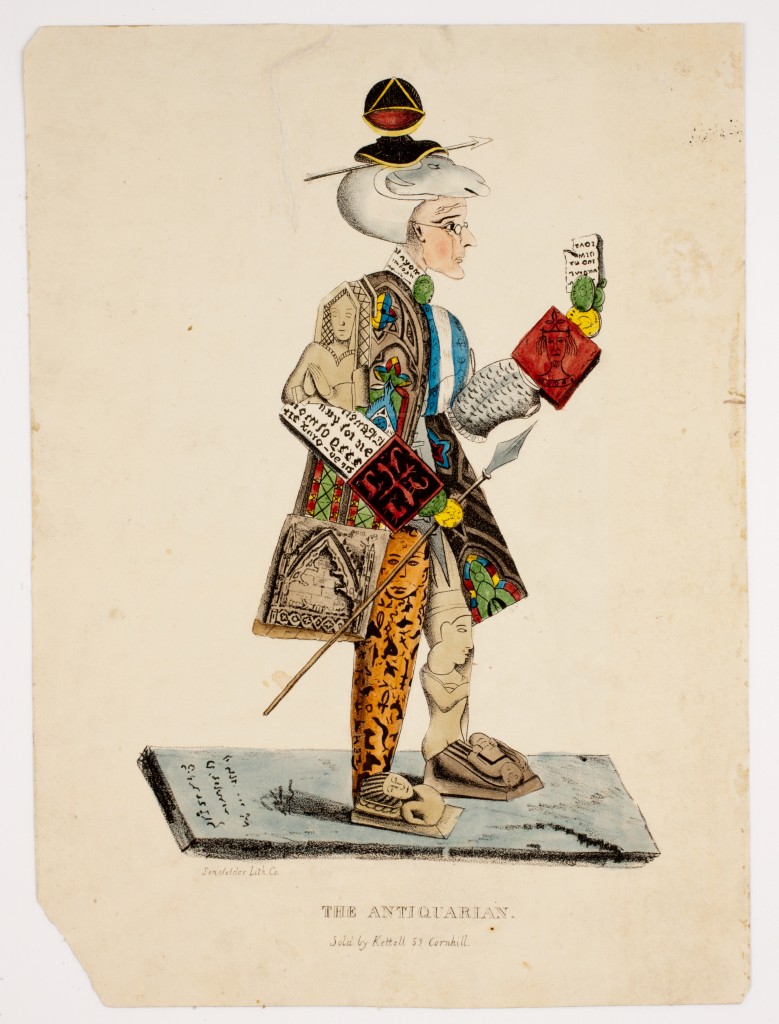This image, a favorite around AAS, is part of a series a lithographs that circulated in the late 1820s and early 1830s, depicting people as an amalgamation of various objects: shells, vegetables, paintings, and in this instance, relics. This graphic motif harkens back to the  Renaissance painter Giuseppe Arcimboldo, whose portrait heads made of similar objects were popular in sixteenth-century Italy. Where Arcimboldo created a head made of books and titled it “The Librarian,” the artist here depicts “The Antiquarian,” made up of manuscript materials and of ancient relics and statutes. Engrossed in his reading, this figure turns away from the viewer, not looking to engage us in any way, but instead, perhaps encouraging us to examine the ancient artifacts that constitute him.
Renaissance painter Giuseppe Arcimboldo, whose portrait heads made of similar objects were popular in sixteenth-century Italy. Where Arcimboldo created a head made of books and titled it “The Librarian,” the artist here depicts “The Antiquarian,” made up of manuscript materials and of ancient relics and statutes. Engrossed in his reading, this figure turns away from the viewer, not looking to engage us in any way, but instead, perhaps encouraging us to examine the ancient artifacts that constitute him.
“The Antiquarian” begs many question, not the least of which is who is this book-clad man? What is the cultural type he represents? And more broadly, who was the early nineteenth-century American antiquarian? And what, if anything, might he (and the antiquarian in the period is always coded male) tell us about our current practices of collecting, organizing, and processing the materiality of the past? Part of the answer to this question can be found in the early documents of AAS. Founding members gave considerable weight to the term “antiquarian,” thinking and writing about the mission that they understood it to embody. They did not consider themselves historians, or even humanists really, but rather, for them, “antiquarianism” was a scientific line of inquiry, with a discrete methodology. In our present moment, their understanding of antiquarianism might help us to challenge disciplinary practices and assumptions that organize scholarly engagement with the past.
As tied to the nationalist project as these founding “American” antiquarians imagined themselves to be, they acknowledged, from AAS’s inception, the precedents for their understanding of themselves and their labor as borrowing from a longstanding British tradition. In their 1812 petition to the Legislature of Massachusetts, the six incorporating members hoped to model themselves after the College of Antiquaries in Ireland, which is, they conjecture “probably the most ancient institution, now existing in the world.” The tradition of antiquarianism is an inherited one, an imported drive to collect and to organize. That impulse, that drive, is, also true to its Enlightenment roots, understood as systematized, as a “science,” though it would take another year before AAS articulated it as such.
In the first annual address to the Society, Reverend William Jenks, who fulfilled several key roles at AAS and who would go on to be a founding member of the Asiatic Oriental Society, defined antiquarianism as part of, but not the same as, either history or poetry. Echoing Aristotle’s definition of Rhetoric as the discipline that allows all other disciplines to do their work, Jenks positions antiquities as so ubiquitous as to ”belong to almost every art and science; and they, who have cultivated art or science with attachment and diligence, may be often benefited by the history of its progress.” The progress of the antiquarian is not “the pleasing task of dwelling on individual characters,” for that is the work of history and poetry, according to Jenks. The antiquarian “aim[s] at objects less exposed to ordinary notice.” The antiquarian is then in part a detective as they “investigate their causes,” laboring in service to time rather than to scholarship or creative enterprises per se. Ten years later, Christopher Columbus Baldwin, AAS’s first fulltime librarian, would make this point in his loving description of time as “the antiquary’s best friend, his right hand man” (Letter to Reverend George Allen, October 20, 1832).
There is much more to be said here about how the work of the antiquarian morphed over the next two centuries into the work of cataloguing, archiving, and collecting, of how the “science” of antiquarianism has become the “science” of information. In the month ahead, as I look at the history of metadata creation here at AAS, I intend to trace some of the genealogy of the organization and preservation of the documentary record in the hopes of elucidating how that genealogy informs and at times disrupts some of the prevailing tenets of the digital humanities.

One thought on “Who is that Book-Clad Man? William Jenks on the Science of Early American Antiquarianism”